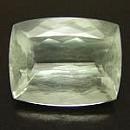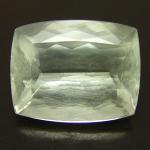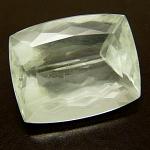|
|
|
|
Click on a letter above to view the list of gems. |
|
|
|
|
|
Magnesite |
|
| Chemistry: MgCO3 | |
| Discovered in 1808; IMA status: Valid (pre-IMA; Grandfathered). Magnesite is named after its chemical composition; principally containing Magnesium. | ||
|
| ||
|
Classification |
|
|
| |
|
Carbonates | |
|
5/B.02-30 | |
|
|
5 : CARBONATES (NITRATES) |
|
Related to: |
Calcite Group: Vaterite, Calcite, Magnesite, Siderite, Rhodochrosite, Smithsonite, Spaerocobaltite, Gaspeite, Otavite. Gaspeite-Magnesite Series and Magnesite-Siderite Series. |
|
|
|
|
Crystal Data |
|
|
|
|
|
Uncommon as crystals. Crystals usually rhombohedral to 30 cm; rarely prismatic, tabular or scalenohedral. Typically massive, coarse- to fine-granular, very compact and porcelainous; earthy to rather chalky; lamellar; coarsely fibrous. |
|
|
Unproven |
|
|
|
|
|
Physical Properties |
|
|
|
|
|
[1011] Perfect, [1011] Perfect, [1011] Perfect |
|
|
Conchoidal |
|
|
Brittle |
|
|
3.5 - 4.5 |
|
|
2.98 - 3.02 (g/cm3) |
|
|
May exhibit pale green to pale blue fluorescence and phosphorescence under UV; may be Triboluminescent |
|
|
Not Radioactive |
|
|
Other: |
Slightly soluble in water with the solubility increasing with the presence of NaCl, Na2SO4, or CO2. |
|
|
|
|
Optical Properties |
|
|
|
|
|
Colorless, white, greyish-white, yellowish, pale green, brown, faintly pink, lilac-rose |
|
|
Transparent, Translucent |
|
|
Vitreous |
|
|
1.509 - 1.700 Uniaxial ( - ) |
|
|
0.191 |
|
|
Very strong |
|
|
Visible |
|
|
|
|
|
Occurances |
|
|
|
|
|
Geological Setting: |
A primary mineral in igneous or sedimentary rocks; formed by metamorphism or alteration of serpentine and peridotite; uncommon in marine evaporites and hydrothermal veins; rare in carbonatites. |
|
Common Associations: |
Antigorite, Calcite, “Chlorite”, Dolomite, Talc |
|
Co-Type Localities: |
Magnisía (Magnesia) Prefecture, Thessalia (Thessaly)
Department, Greece. |
|
Year Discovered: |
1808 |
|
View mineral photos: | |
|
|
|
|
More Information |
|
|
|
|
|
| |
|
|
|
|
|
|
|
|||||||||||||||||||||||||||


